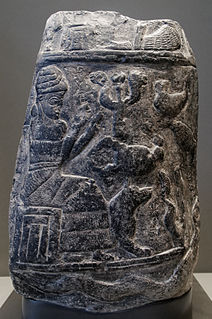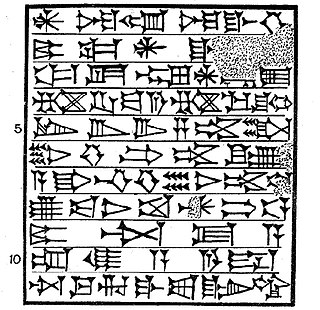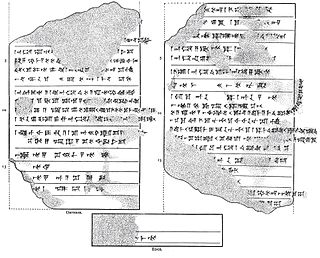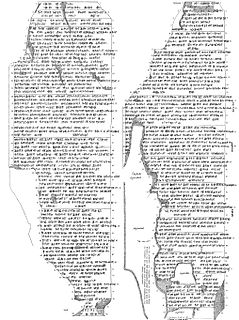
Marduk-apla-iddina I, contemporarily written in cuneiform as dAMAR.UTU-IBILA-SUM-na and meaning in Akkadian: "Marduk has given an heir", was the 34th Kassite king of Babylon ca. 1171–1159 BC. He was the son and successor of Melišipak, from whom he had previously received lands, as recorded on a kudurru, and he reigned for 13 years, during a time when the Dark Ages cast a heavy cloud over the contemporary events.
Erība-Adad II, inscribed mSU-dIM, “Adad has replaced,” was the king of Assyria 1056/55-1054 BC, the 94th to appear on the Assyrian Kinglist. He was the son of Aššur-bēl-kala whom he briefly succeeded and was deposed by his uncle Šamši-Adad IV.
Aššūr-bēl-kala, inscribed maš-šur-EN-ka-la and meaning “Aššur is lord of all,” was the king of Assyria 1074/3–1056 BC, the 89th to appear on the Assyrian Kinglist. He was the son of Tukultī-apil-Ešarra I, succeeded his brother Ašarēd-apil-Ekur who had briefly preceded him, and he ruled for 18 years He was the last king of the Middle Assyrian Empire, and his later reign was preoccupied with a revolution against his rule led by one Tukulti-Mer, which, by the end of his reign, allowed hordes of Arameans to press in on Assyria's western borders. He is perhaps best known for his zoological collection.
Ašarēd-apil-Ekur, inscribed ma-šá-rid-A-É.KUR or mSAG.KAL-DUMU.UŠ-É.KUR and variants, meaning “the heir of the Ekur is foremost,” was the son and successor of Tukultī-apil-Ešarra I as king of Assyria, reigning for just two years, 1076/5–1074 BC, during the turmoil that engulfed the end of that lengthy reign, and he was the 88th king to appear on the Assyrian King List. His reign marked the elevation of the office of ummânu, “royal scribe,” and he was the first to have this recorded next to the king’s name on the Synchronistic King List, possibly identifying the contemporary redactor of this list.
Enlil-nirari was King of Assyria from 1330 BC to 1319 BC, during the Middle Assyrian Empire. He was the son of Aššur-uballiṭ I. He was apparently the earliest king to have been identified as having held eponym, or limmu, office.

Kaštiliašu IV was the twenty-eighth Kassite king of Babylon and the kingdom contemporarily known as Kar-Duniaš, c. 1232–1225 BC. He succeeded Šagarakti-Šuriaš, who could have been his father, ruled for eight years, and went on to wage war against Assyria resulting in the catastrophic invasion of his homeland and his abject defeat.

Marduk-nādin-aḫḫē, inscribed mdAMAR.UTU-na-din-MU, ca. 1099–1082 BC, was the sixth king of the 2nd Dynasty of Isin and the 4th Dynasty of Babylon. He is best known for his restoration of the Eganunmaḫ in Ur and the famines and droughts that accompanied his reign.

Marduk-zâkir-šumi, inscribed mdPA-za-kir-MU in a reconstruction of two kinglists, “Marduk pronounced the name,” was a king of Babylon 855-819 BC during the mixed dynastic period referred to in antiquity as the dynasty of E. He was a contemporary of Assyrian kings, Salmānu-ašarēdu III) and Šamši-Adad V with whom he was allied.
Agum III was a Kassite king of Babylon ca. mid-15th century BC. Speculatively, he might figure around the 13th position in the dynastic sequence; however, this part of the Kingslist A has a lacuna, shared with the Assyrian Synchronistic Kinglist.

Kurigalzu II was the 22nd king of the Kassite or 3rd dynasty that ruled over Babylon. In more than twelve inscriptions, Kurigalzu names Burna-Buriaš II as his father. Kurigalzu II was placed on the Kassite throne by the Assyrian king Aššur-Uballiṭ I, reigned during a period of weakness and instability for twenty five years, eventually turning on his former allies and quite possibly defeating them at the battle of Sugagu. He was once thought to have been the conqueror of the Elamites but this now tends to be assigned to the earlier king of this name, together with the Chronicle P account.
Kudur-Enlil, Ku-durdEN.LÍL, “son of Enlil,” was the 26th king of the 3rd or Kassite dynasty of Babylon. He reigned into his ninth year, as attested in contemporary economic tablets. His relationship with his predecessor and successor is uncertain and does not appear in contemporary inscriptions.

Marduk-šāpik-zēri, inscribed in cuneiform dAMAR.UTU-DUB-NUMUN or phonetically -ša-pi-ik-ze-ri, and meaning “Marduk (is) the outpourer of seed”, ca. 1082–1069 BC, was the 7th king of the 2nd dynasty of Isin and 4th dynasty of Babylon and he ruled for 13 years. His relationship with his predecessor, Marduk-nādin-aḫḫē is uncertain. His reign overlapped that of the Assyrian king Aššur-bēl-kala and his immediate predecessor(s) as the Synchronistic King List places him alongside both Tukultī-apil-Ešarra and Aššur-bēl-kala.
Itti-Marduk-balāṭu may refer to
Eulmaš-šākin-šumi, inscribed in cuneiform as É-ul-maš-GAR-MU, or prefixed with the masculine determinative m, “Eulmaš (is) the establisher of offspring”, ca. 1004 – 987 BC, was the founder of the 6th Dynasty of Babylon, known as the Bῑt-Bazi Dynasty, after the Kassite tribal group from which its leaders were drawn. The Dynastic Chronicle tells us that he ruled for fourteen years, the King List A, seventeen years.
Ninurta-nādin-šumi, inscribed mdMAŠ-na-din-MU or dNIN.IB-SUM-MU, “Ninurta (is) giver of progeny,” c. 1132-1126 BC, was the 3rd king of the 2nd dynasty of Isin and 4th dynasty of Babylon. He reigned for seven years, contemporaneously with Aššur-reš-iši, c. 1133 to 1115 BC, the Assyrian king with whom he clashed.

Uballissu-Marduk, inscribed ú-ba-lí-su-dAMAR.UTU, meaning “Marduk has kept him alive,” was a Babylonian accountant (niğkas) who rose to the rank of administrator (sanqu) in the Kassite government of Kurigalzu II, ca. 1332-1308 BC short chronology, whose principal sources are his two cylinder seals which detail his religious affiliations and his illustrious genealogy.
The office of šandabakku, inscribed 𒇽𒄘𒂗𒈾 (LÚGÚ.EN.NA) or sometimes as 𒂷𒁾𒁀𒀀𒂗𒆤𒆠, the latter designation perhaps meaning "archivist of Enlil," was the name of the position of governor of the Mesopotamian city of Nippur from the Kassite period onward. Enlil, as the tutelary deity of Nippur, had been elevated in prominence and was shown special veneration by the Kassite monarchs, it being the most common theophoric element in their names. This caused the position of the šandabakku to become very prestigious and the holders of the office seem to have wielded influence second only to the king.

Chronicle P, known as Chronicle 22 in Grayson’s Assyrian and Babylonian Chronicles and Mesopotamian Chronicle 45: “Chronicle of the Kassite Kings” in Glassner’s Mesopotamian Chronicles is named for T. G. Pinches, the first editor of the text. It is a chronicle of the second half of the second millennium BC or the Kassite period, written by a first millennium BC Babylonian scribe.














